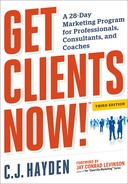Recipe: Sending Direct Mail by E-mail or Post
There is a significant difference between postal direct mail or unsolicited bulk e-mail and sending personal letters or e-mails to prospective clients, which is discussed earlier in this chapter. This difference is marked by both the level of individual attention you give each communication and the volume of marketing pieces you send. And the difference in the impact these two tactics will have is equally significant.
Think of yourself as an example. How much of the mail arriving in your mailbox or e-mail inbox do you actually read? Do marketing letters you get with your name inserted fool you into thinking the letter was written just for you? Who are you more likely to contact—someone who sent you a pitch by mail or e-mail, or someone who was recommended by a friend?
Most people routinely discard mail from senders they don’t recognize. If they do hang on to your mailing, it will probably be sitting at the bottom of a to-be-reviewed stack somewhere. This is why calling before you send a personal letter is so important. It may be the only way to save your letter from oblivion. And calling after you send it is the only way to know if it was read.
Sending a generic letter or e-mail to a large mailing list is much better used as a follow-up technique than for filling the pipeline. (See Chapter 8 for more about this.) If despite these warnings, you want to try using direct mail as your first approach to a cold list, use only postal mail for this purpose. Don’t even think about sending unsolicited bulk e-mail—that is, spam.
To use postal direct mail, consider working with a marketing communications specialist to design the ad copy and layout for your mailing. Getting professional help to compose your letter, design your mailer, or lay out your postcard can greatly increase its effectiveness.
Try offering a free gift, complimentary consultation, or other time-limited offer as an incentive for the recipient to call you or visit your website. If your mailing is enclosed in envelopes, paying someone to hand-address them is one way to increase the odds of your letters being opened. Printing a teaser on the outside—“Look inside for your free gift”—is another. Just be sure whatever tricks you use to get your mailing piece noticed reflect the professional image you want to present.
Remember, too, as with all forms of written outreach, you will get much better results from direct mail if you couple it with follow-up phone calls.
Recipe: Print and Online Directory Advertising
One of the most popular advertising venues for service businesses is the advertising directory. In print, this category includes the Yellow Pages produced by your local phone company; similar directories produced by competing groups; and membership directories and resource guides printed by associations and unions.
On the Web, directories include local business directories, membership directories for associations and trade groups, and specialized directories for specific market niches. For example, a wedding planner could advertise in WeddingChannel, or an acupuncturist could purchase a listing in Acufinder.
Some directories may offer a basic listing for free, or as a benefit of your membership or paid service. It can be worth your time to create listings in some of these—for example, the local business directories offered by Google Places, Yahoo! Local, or Yelp. Keep in mind that once you do this, you may start to receive online reviews, which are not always positive or accurate.
Most directories will tempt you to upgrade your basic listing to a paid one, or if you are already paying, to add options that cost more. There are really only two reasons to pay to advertise in a particular directory:
1. You expect that potential clients will be looking for your service in that directory at the time they are ready to buy. If you’re not sure about this, ask some colleagues what their experience has been with specific directories.
2. It is a standard practice in your industry to be listed in that directory, so it would detract from your credibility if you weren’t included.
When advertising solely for the second reason, there’s no point in buying a big ad. Just get the basic listing. Even well-established companies often keep this type of ad quite small.
When you are advertising for reason 1, it’s important that your ad copy and layout be designed to catch the eye of your best prospects. Study the existing ads in your category carefully. Make yours stand out by using unique graphics or an intriguing headline. If there are many large ads in your category already, recognize that a smaller ad will have a hard time competing.
Rather than packing lots of information into your ad, focus on one key benefit you provide or one problem you solve for your clients. On a page filled with ads for psychotherapy, most of which mention depression, relationship problems, and eating disorders, an ad highlighting “recovery from trauma” could stand out and attract someone for whom this is an issue. If you can’t decide which of your services to promote, pick the one no one else is advertising. Remember that the sole purpose of an ad like this is to get prospects to contact you. Once you speak with them to find out about their needs, you may be offering them something different.
Beware of new, untested directories. Just because a vendor prints 50,000 copies or launches a good-looking website doesn’t mean anyone will be using this directory to find professionals to work with.
